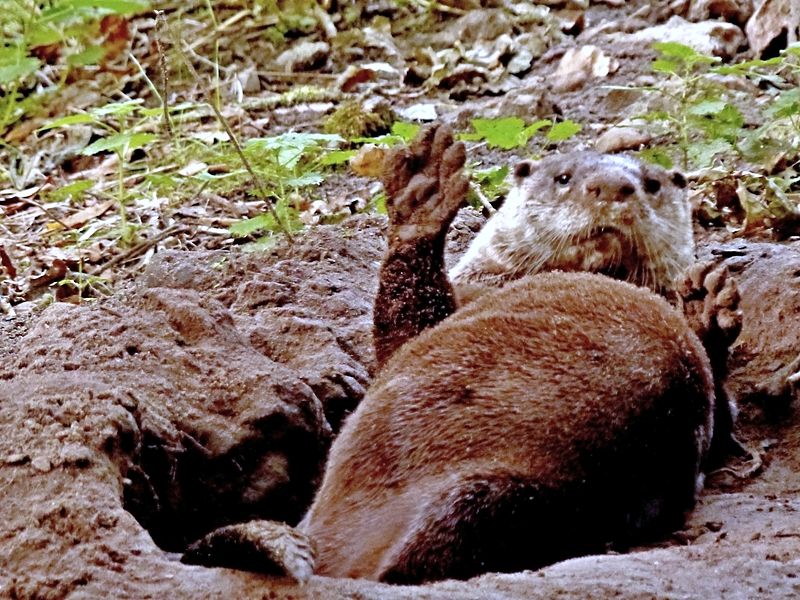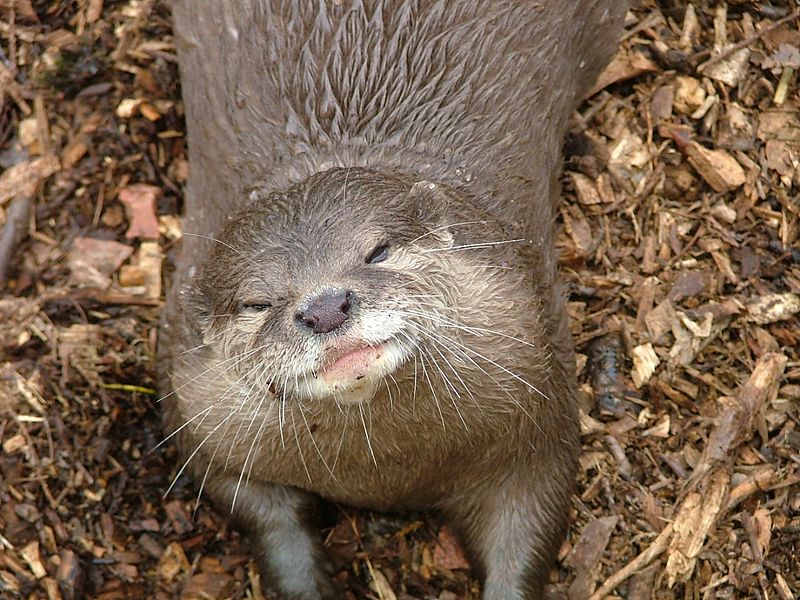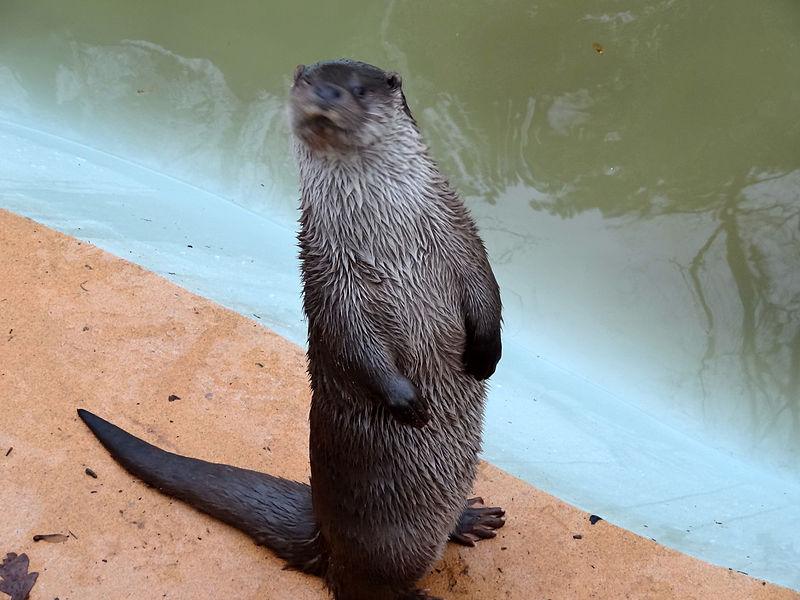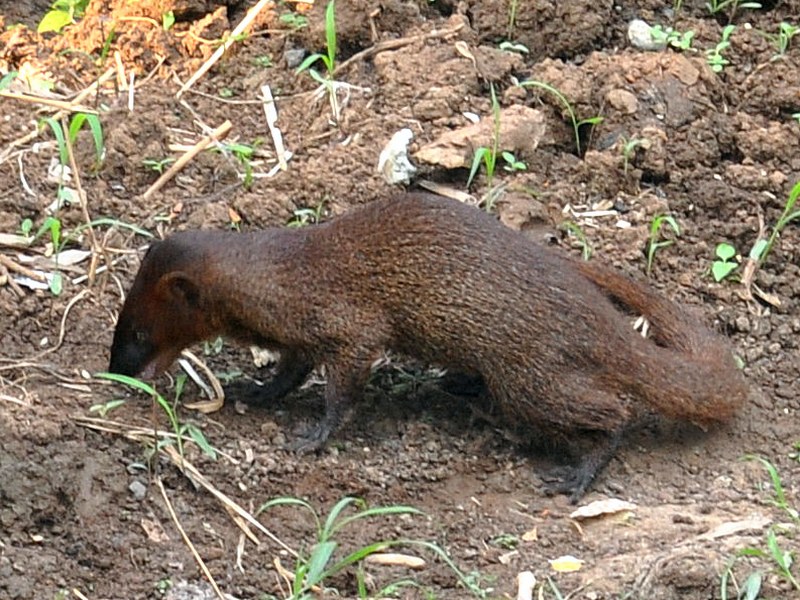Legal Status
Wildlife Act 1976 / 2000
EU Directive 92/43 Annex II, Annex IV
Bern Convention Appendix III
Key Identification Features
The Eurasian otter is a member of the Mustelid family which includes stoats, minks and pine martens in Ireland. They can be distinguished from other Mustelids by their long slender bodies, short legs and long thick tail which tapers off to a point. The head is broad and flat in shape with small forward looking eyes and small rounded ears. Long whiskers protrude from the muzzle. Colouration consists of a thick dark brown coat on their backs with a more grey brown tint on the under belly. The throat area is a pale creamy white colour. Males are larger and heavier than the females with an average adult male’s body and head measuring up to 90cm with a 40cm long tail. Female’s head and body length average up to 80cm with a 35cm long tail. Males when fully grown can weigh up to 11kg with females weighing much less averaging only 7kg. Otter tracks consist of five digit prints which can show webbing and claws on all four feet usually measuring between 6cm and 7cm in length. Otters are agile swimmers with the ability to dive underwater for up to forty seconds in search of prey, when on the surface only the head and part of the tail is visible. On land the otter bounds instead of runs with its head low to the ground. Otters are not particularly vocal but will emit a whistle sound to communicate with more chuckles and chatters being heard during the mating season. As the otter is quite elusive evidence of their droppings called spraints is one way of identifying their presence in an area. They will regularly use the same areas to deposit their spraint which will mark their territories or an area they regularly use for fishing, resting or grooming. The spraint will contain scent information that other otters can use to determine an individual’s age, sex and territorial range. Spraint sites will be located at landmarks such as on large rocks, on high vegetation mounds or under bridges.
Habitat
Otters are found in a variety of aquatic habitats in Ireland such as lakes, rivers, streams, estuaries, marshland, canals and along the coast. Coastal dwelling otters require access to a freshwater source as they must regularly cleanse their fur of salt as this can effect its insulating properties. Any aquatic environment which has nearby vegetation or rock cover will be used by otters. Several holts will be located within an individual’s territory, lying up sites known as couches will also be used at ground level within a vegetated area which may be linked to the water by a regularly used path which can be accessed quickly to slide into the water. Holts are the main den locations used by otters and can be situated underground along a river’s bank or among the root systems of trees. Otters prefer to use vacated rabbit dens or fox earths rather than excavate their own burrows. Holts are lined with dried vegetation and usually have several entrances some of which can only be accessed from underwater. An individual otter’s territory may contain several holt and couche sites along a linear home range parellel to a river, lake or canal.
Food and Feeding Habits
Otters are nocturnal carnivorous hunters remaining within a holt for most of the day. Coastal dwelling individuals are generally more active in the daytime compared to those who occupy freshwater habitats. The otters diet is large and varied depending on the local abundance of a particular prey item and its seasonal availability. For those occupying freshwater habitats the preferred food items are fish particularly salmon, trout, perch and pike. In such areas they will also hunt frogs, small mammals and some waterfowl species like duck, moorhen and coot. They are also known to eat carrion if they find a recently deceased animal. Otters in coastal areas will hunt eel, crab, sea urchins and mollusces. In clear waters the otter relies on its strong eyesight to locate its prey which will usually be located along the bottom. In dark or muddy waters the long whiskers known as varrsse will be utilized to detect movement. Most prey will be eaten while on the surface as the otter floats but larger prey must be dragged ashore before it can be eaten.
Reproduction and Life Cycle
Otters can breed in Ireland year round but mating usually occurs in spring and summer, females will breed only once per year. Otters will become much more vocal during the breeding season with fights among males commonplace. Copulation can occur on land or in the water and is quiet vigorous. Unusually for members of the Mustelid family the male will remain with the female for up to two weeks after a successful courtship. Unlike stoats and pine martens gestation is not delayed with pregnancy lasting just over two months. Otters will give birth to an average of three cubs preferably in summer to maximize their chances of survival. Cubs are fully furred when born and first open their eyes after five weeks. The mother otter will nurse the cubs for up to fifteen weeks by which time they will have become able swimmers. Otter cubs have been known to stay with their mothers for up to one year and can be seen in family parties learning hunting techniques. Mortality rates are low if the cubs are born in the summer and they can expect to live for up to 5 years on average in the wild in Ireland.
Current Distribution
The Eurasian otter ranges from western Europe east through Asia and on to China and Japan. They are only absent in this area in Iceland and on some of the Mediterranean islands. Otters are believed to have come to Ireland at the end of the last ice age around 10,000 years ago with evidence of their bones being found in Bronze Age sites dated from 4,000 years ago. The species is now present throughout the island of Ireland and can occupy any habitat area which has either a fresh or saltwater source. They have also spread into urban areas with the creation of canals and other artificial water bodies. As they are so elusive it is not known how many individuals there are per square kilometer but best estimates put their numbers at 4 individuals per km2 in good freshwater habitats like those found around midland lakes and at 1 per km2 along the coast.
Conservation Issues
The Eurasian otter is in decline everywhere in their traditional home ranges except in Ireland where the densest population now exist. Most populations of otters in Europe are listed as being vulnerable, in decline or extinct making the Irish population all the more important. The practice of hunting and trapping is now banned but the destruction of their habitats, human disturbance and falling water quality levels are a threat to the Irish otter population. If cubs are born in winter or early spring mortality rates are high. Man is the main cause of otter death due to increased road traffic and the accidental drownings of coastal otters in lobster pots and fish nets. Dogs also account for a number of otter cub deaths each year. Otters can cause damage to fish hatcheries and farms so adequte fencing is needed in such areas. Competition with increasing American mink numbers for similar food sources may have a detrimental effect on otter numbers in the future. Reflecting its importance the Eurasian otter is a protected species under Irish, EU and international legislation.





